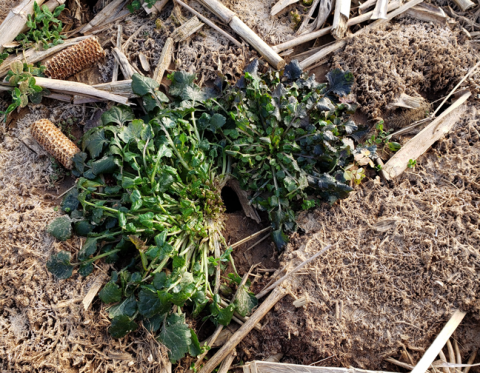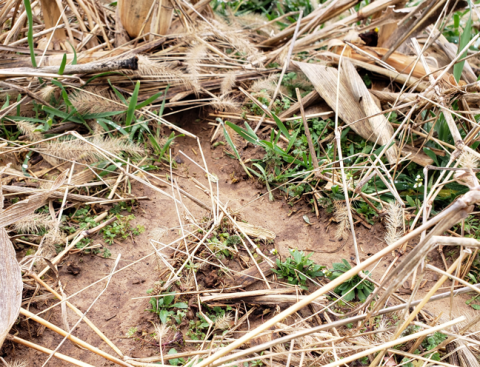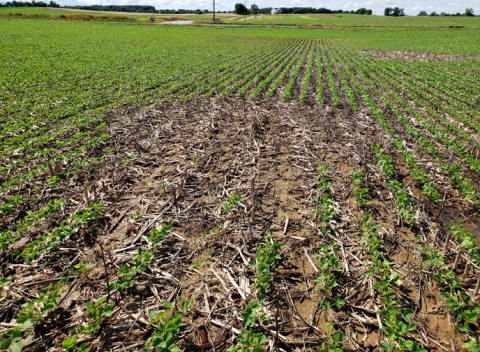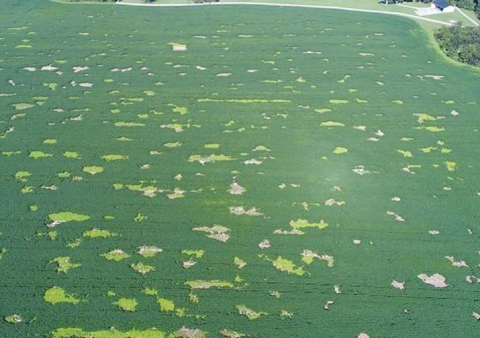Vole Damage Issues
Vole Information:
Click on the following links to learn more:
Voles can cause a wide variety of damage to many different landscape settings such as lawns, orchards, and agricultural fields. In landscaping, voles are considered a nuisance species. In lawns, voles can kill newly planted shrubs or trees by gnawing the bark. Flower bulbs, garden plants, and vegetables are often sought out food items, this then damages or kills them. They can occasionally make it difficult to establish annuals. Also, look for surface ground runways that voles will create. The runways will appear as a worn down path in thick vegetation often about two inches thick.
Row Crop Concerns
Damage can be very apparent in agricultural fields when vole populations are at high levels. Damage will often be found next to or near field edges and close to waterways. These areas tend to provide the most habitat year round and act as a potential source population when crops are planted. Voles will consume planted seeds or clip off the tops of growing plants in fields. This will cause gaps in crop vegetation, leaving a crop circle appearance. The gaps in crops allow for unwanted weed species to grow. This had been most obvious in soybean fields. In the fields, voles will establish surface runways. The runways will consist of closely clipped vegetation and have a width of about two inches.
To assess if there is potential for vole damage, it is best to scout fields prior to planting. In cover crops, look for darker colored patches of crops. These areas could be the location of a vole colony where there is a higher amount of scat and urine fertilizing the crops. Surface runways will also be moderately visible. The runways often have a worn-down path that stands out compared to the rest of the vegetation. A vole colony will consist of multiple entrances or burrows in a single location. The size of the burrow entrance will be the size of a golf ball or smaller. An active vole colony may have scat by the entrance of the burrow or freshly clipped vegetation around the burrow. The entrance will appear to be slick while an un-active colony will appear more dried out or not as well maintained.
Lawn Concerns
Voles can cause unsightly issues in yards for homeowners. Usually these manifest themselves through the appearance of multiple golf ball sized holes spaced closely together. Runways for the animals, feces, and potentially loss of grass from consumption may also be visible. Due to the nature and size of lawns it is possible to control them with snap traps over a period of 1-2 weeks. The sooner you find the colonies the shorter the time to rid yourself of them. Regular mouse sized traps baited with peanut butter and oats will work. Place traps at ¼- 1/3 of the total number of burrow openings and cover them with a piece of cardboard to prevent birds from accessing them. Check them daily and continue trapping until no animals are caught for three consecutive days.
Orchards/Berry Production
In orchards or blueberry production systems, if voles are present this will be shown by girdling or gnaw marks on trees/bushes. Plants that have damage by voles will have irregular spaced gnaw marks at the base of the tree. However, this is not to be mistaken with rabbit damage which will have regularly spaced gnaw marks. If rabbits are causing the damage, lower branches will also be cleanly clipped off. Also, keep an eye out for runways leading up to the trees. For more information on identification or control please refer to the University of Kentucky Horticulture Extension video on vole control in blueberry production here.

Vole Tunnels
Vole tunnel hidden by vegetation, no distinct runways visible.

Tunnel/Runways
Vole tunnel and defined runways.

Soybean Field
Vole colony located in the middle of a soybean field. No soybeans were able to grow within close range of the colony’s tunnels as they were all consumed by the voles.

Vole Damage
Aerial photograph of severe vole damage caused by dozens of colonies located in a soybean field.
